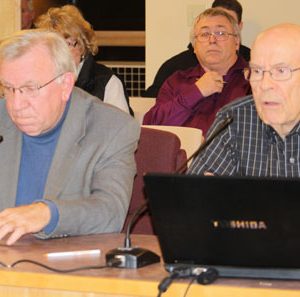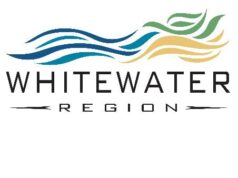by CONNIE TABBERT
Editor
COBDEN — Cobden resident Donald Deer and consultant Michael Michalski are hoping for $93,000 from Whitewater Region’s 2016 budget to help pay for a management plan with ideas on how to clean up Muskrat Lake.
The two spoke at the township’s Dec. 2 environmental services committee meeting.
Mr. Deer noted there is currently no plan for remediation of Muskrat Lake. However, Mr. Michalski has a proposal to clean up the lake, he said.
“I’m the bad guy here,” is how Mr. Michalski began his presentation, noting he was hoping for almost $100,000 for a proposal to clean up Muskrat Lake.
He reviewed his professional career, which began back in 1966.
“For nearly 50 years, I’ve been working on water projects,” he said.
He has worked with the Ontario Water Resources Commission, which eventually became a part of the Ministry of Environment (MOE). This commission went around the province creating water and sewage treatment plants, he said.
In 1974 he left his management position with the MOE, and began his own consulting firm, which was related to working on lakes, rivers and streams.
In 1981, he did some consulting work regarding Muskrat Lake and at that time advised the lake was badly enriched with phosphates. The nature of that project was through the Drainage Act and it was to turn wetlands into agricultural lands, Mr. Michalski said.
“I said at that time if you do this, you will increase the phosphate load to the lake…and aggravate the problem,” he recalled. “I made some recommendations…because at that time it was highly enriched,” he said.
Mr. Michalski then reviewed some of the projects he has been involved with over the years.
Going back to the current issue, he said, “Muskrat Lake has a number of point sources of phosphorous, from agricultural input, from the sewage treatment plant, and another very, very key important source of phosphorous that nobody knew, in 1981 I wasn’t aware of, is from the sediments, the internal sediments of the lake, the deep water sediments of the lake.”
In July through October those sediments, if brought to the surface, would smell like rotten eggs, he said.
“Phosphorous is released from the sediments and it’s staying there in the lower 20 to 30 metres of water, so when the lake turns over in the fall, that supply of phosphorous is available later on and for the next spring,” he explained.
The concentrations of phosphorous are about 200 micrograms per litre, he said.
“That is higher than what is coming out of good, treated sewage systems,” he said.
Mr. Michalski prepared a proposal that could be read and understood by staff at Ministry of Natural Resources level and the public.
“It consists of getting the best people I know in North America together in one room who have a lot of experience, a lot of talent, and prepare a lake restoration plan for Muskrat Lake,” he said.
The main objective would be to evaluate the technical feasibility, the environmental feasibility, the cost of a number of different restoration techniques, with a view of coming up with the best resolution for the lake, Mr. Michalski said.
There would be a one-week workshop which would be a framework for a management plan, he said, which would take about two months to complete.
Prior to completing the management plan, there would be three tasks that need to be completed, Mr. Michalski said.
The first task is to complete logistical work, he said.
“We can’t just go after the lake, we have to go after the watershed,” Mr. Michalski said.
“That means this assignment is so much more complex” than some of the projects he has been involved with.
He noted that most of the work has been completed, it’s just a matter of putting it together.
“We are not going out and reinventing the wheel,” Mr. Michalski said. “We have enough information to make decisions with what we have.”
The items to be completed in the first task includes pre-meeting information and review, checking out land use maps and lake morphometry, water chemistry, temperature and dissolved oxygen profile, inflow and outflow volumes and the historical and updated phosphorous budget as well as the physical and biological characteristics of Snake and Muskrat rivers.
Task two would be to gather together the workshop participants, which include representatives from various ministries and companies, including Ministry of Natural Resources, Tetra Tech, Enviro Sciences and the Ontario Ministry of Agriculture, Food and Rural Affairs, Mr. Michalski said. Tetra, out of Seattle Washington, deals only with lake restoration projects, he noted.
“These are the people I think are going to be able to pull a management plan together,” he said. “They have the experience you want.”
The people to be involved need to “think outside the box,” he said. “This problem here is too diverse, too complex, to not think outside of the box.”
He noted that lake restoration is a low level priority for provincial ministries. When he worked for the MOE, there was a Lake Restoration section; but after he left, the Liberal government decided there would be no more lake restoration, but instead go after it from a preventative point of view.
While he agreed with that, Mr. Michalski said lake restoration was still needed, because there are areas where lake restoration is required.
And Task three is to prepare a water quality management plan, which would include a draft management plan, a final management plan, and will include Ontario Regulations for lake restoration.
There are reasons for this study, Mr. Michalski said, including getting a legitimate solution from knowledgeable experts; there is no feasible alternative; so there can be future development around Muskrat Lake; and for increased tourism, the water quality has to improve.
The management plan will state what has to be done and if it’s done, here’s how much improvement you will find and here’s how long it will take to reach that improvement and here’s the prognosis for a longer term, Mr. Michalski said. However, if it’s only the lake worked on, and not the watershed, there will not be optimum water improvement, he stressed.
Mr. Michalski noted the total cost being requested from the township is $93,593.
He said there is funding available from the Drainage Investment Group, but the application must come from the municipality.
“(This group) helps secure funds for projects under the Drainage Act as long as those funds are being used to benefit a lake or a drain from an environmental perspective,” he said.
Mr. Deer said he is looking for other funding, but he warned council that most funding will only be about 50 per cent of the costs.
Mr. Michalski said, “What we would really like is your support for our proposal so we can go forward and help the municipality secure the necessary funds and move the plan forward.”
Councillor Daryl McLaughlin, who is chair of the committee, thanked Mr. Michalski and Mr. Deer for bringing this presentation to the committee.
“You’ve given us a lot of food for thought,” he said. “We will look at it when it comes to budget time.”
Chief Administrative Officer Christine FitzSimons noted the Muskrat Lake Watershed Council, which provided a report for the committee meeting, wrote a letter of support for Mr. Deer and Mr. Michalski’s endeavour as they look for grant funding.
“There is a spirit of co-operation here that I think should be applauded,” she said.






![Kenopic/Smith Auction [Paid Ad]](https://whitewaternews.ca/wp-content/uploads/2018/10/advertising-100x75.jpeg)

